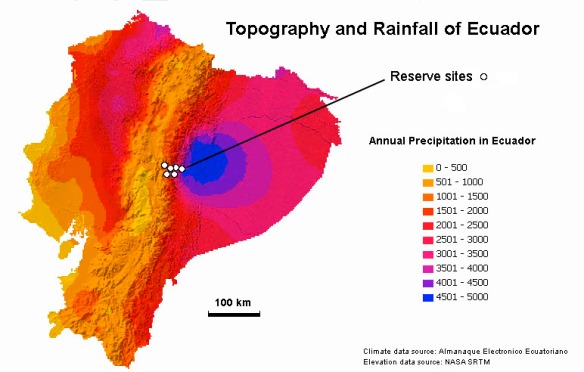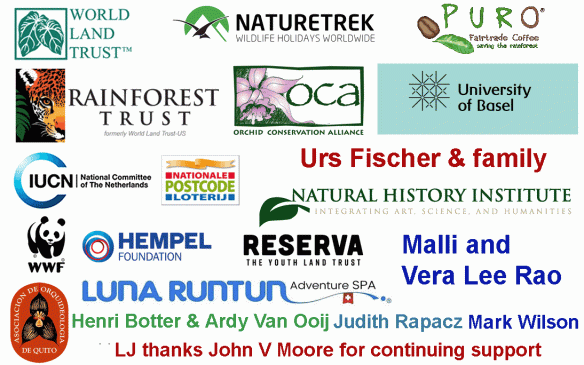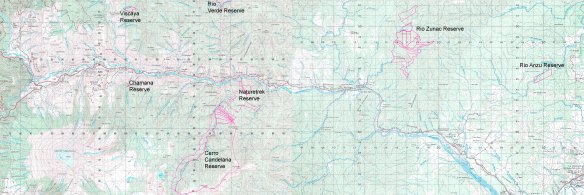This blog keeps you updated about EcoMinga’s conservation work in Ecuador, and gives news about the plants and animals of our reserves there (discoveries, rare sightings, etc). We also have an older website,
href=”http://www.ecominga.net/” target=”_blank”>www.ecominga.net, but that site is not being updated. We direct readers here for live updates.

Our eastern Andean reserves. See more detailed map below. Our new northwestern reserve, the Dracula Reserve, is still being assembled and is not shown on this map.
Fundacion EcoMinga (EcoMinga Foundation in English) is an Ecuadorian foundation with international sponsors, dedicated to the conservation of the unique foothill forests, cloud forests, and alpine grasslands (“paramo”) of the Andes, especially those on the edge of the Amazon basin in east-central Ecuador and those on the super-wet western Andean slopes of the Choco region in northwest Ecuador. The foundation was established in Ecuador in 2006, under the statutes and supervision of the Ecuadorian Ministerio del Ambiente. Its current directors and advisory board members include Juan Manuel Carrion, Mario Yanez, Renato Valencia, Catalina Quintera, Xavier Silva, Flavia Alban, Juan Kohn, Monica Andrade, Lou Jost, Lori Swanson, Juan Miguel Espinoza, Natalia Espinoza, Chiara Correa, Francesca Rota, and Simon Cordero Espinoza. Jo Twelvetrees, Calaway Dodson, Howard Teitch, and Nigel Simpson are former directors who are now honarary directors. Javier Robayo is our Executive Director and west Andean reserve manager, Juan Pablo Reyes is our east Andean reserve manager, and Lou Jost is the current president.
In the upper Rio Pastaza watershed (east-central Ecuador) between Banos and Puyo we have established ten reserves covering all elevations from 1100m to 3860m. Each of these reserves contains unique plant and animal species endemic to this watershed. These include the Rio Anzu Reserve (1100-1200m elevation, Amazonian foothill forest on limestone), Rio Zunac Reserve (1300-2200m elevation, very diverse cloud forest on granite), Rio Verde Reserve (2200-3000m elevation, cloud forest on volcanic rock), Cerro Candelaria (1700-3860m elevation, many different habitats including alpine grassland; our largest reserve with ca. 2700 hectares), Naturetrek Reserve (1500-2000m, rich cloud forest), Viscaya Reserve (2400-3100m, wet high cloud forest), Olivier Currat Reserve (2800-3200m, cloud forest) and Chamana Reserve (2400-2600m, windy cloud forest). The total area protected is almost 5000 hectares (12000 acres). Most of these reserves adjoin national parks, which protect higher-elevation habitats; we extend their protection down into the much more diverse middle and lower elevations which are not protected. Click on the map below to enlarge. This map does not contain all Banos-area reserves, I will update it shortly.
More recently we have established the Dracula Reserve (named for Dracula, a genus of rare orchids) and Manduriacu Reserve in northwestern Ecuador. More information appears about those reserves elsewhere in elsewhere in this blog.Like our eastern Andean reserves, these reserves protect local centers of endemism that are not protected by Ecuador’s national parks or protected areas.
We need your help to continue protecting these forests. If you can, consider donating to EcoMinga. See our Donation page for instructions.
Este sitio da noticias sobre el trabajo de la Fundacion EcoMinga en el Ecuador, y tambien sobre nuestras animales y plantas. Por favor vease www.ecominga.net o www.loujost.com para mas informacion sobre estos temas. Lamento que en este momento casi todo esta en ingles, pero poco a poco vamos a cambiar esto.
Gracias, thanks for visiting,
Lou Jost



Hi Lou, I was in the audience at World Land Trust 25th anniversary event at the BAFTA theatre, I really enjoyed your presentation – shame you didn’t get more time up there on stage, really inspiring stuff!
Scott
Hi Scott, thanks very much for your comment. I enjoyed giving that presentation, in spite of the time pressure. I hope to flesh out the presentation in posts on this blog.
Brilliant work, Lou. Can you somehow embed a ‘donate’ tab on this site, or include instructions for making donations somewhere?
Thanks very much Steve.
I think WordPress doesn’t allow PayPal buttons or similar things, but our website, http://www.ecominga.net, has a page about how to donate (though it is a bit out-dated). In the US, the Orchid Conservation Alliance maintains a PayPal button for us; I’ll make a tab here on the WordPress blog to direct people to it. US residents can get a tax deduction if they go this route. Donors need to write me to let me know that they have done this, so I can follow up with it; write to my gmail account, username loujost. People in the UK can donate to the World Land Trust. People in other countries should write me directly; we have partner foundations in some countries that can accept donations and pass them to us.Note added Nov 15 2014: I’ve just added a Donate tab to our home page menu with full info about how to donate. Thanks for writing!! Best, LouSteve, see my addition to my previous comment– there is now a Donate tab on our home page. Thanks again, Lou
I just found a Siphlophis ayauma on the road. Dead head smashed probly by car
hola necesito visitar esta área y no se como acceder, me podrías ayudar con la información, gracias…
Acabo de ver tu mensaje. Puedes escribirme a loujost por gmail.com.
Hello Lou and Javier, I would live to meet with you soon to lean more about What Ecominga is doing. Your accomplishments are impressive. I am Taking 4 months off to work on some reforestation and other projects in Tena.
I hope we can talk soon.
Mike Mccolm
Lou, Congratulations – what an honor for you and EcoMinga to be added to the IUCN.
Thank you Judith, and thanks also for your help with our projects and my research.
Hi Lou, My friend David Geale http://www.mariposabutterflytours.com and I are planning a scouting trip for butterfly photography to Ecuador next September, and Ursula Gelchsheimer suggested we visit Finca Palmonte, which is one of your reserves I think. Could you send me some info on arranging visits maybe to some of your other reserves as well? How’s the access? Places where we can stay? We won’t be collecting, just doing photography. I’ve been building a database of neotropical butterfly photos since the early 2000’s, you can see some of our photos at my site http://www.neotropicalbutterflies.com, and some of our Colombian PDFs at https://www.butterflycatalogs.com, hover over PDFs and click on Families or Locations.
Hi Kim,
Finca Palmonte is a very nice private reserve, but it is not connected with EcoMinga. We have many reserves, which you can read about on this blog. I would recommend our Rio Anzu Reserve (though be careful about poisonous snakes), and our Rio Zunac Reserve as a second choice. Finca Palmonte would make a comfortable base from which to visit our reserves. Write me directly for more info. I have a gmail address, user name loujost.
Hi Lou and Kim,
I hope that in Costa Rica, there can/will be more conservation groups akin to the one that I am familiar with in Ecuador, as documented and promoted by one of my other websites at https://queenslandorchid.wordpress.com/2014/08/31/jatun-sisa-botanical-garden-and-sanctuary-of-wildlife/
There is now a biotechnological research division in the JATUN SISA Botanical Garden created by your young scientists in the biotechnological engineering discipline in the Ecuadorian Amazon.
Happy new year to you soon!
Pingback: La corsa all’oro mette a rischio la nuova rana trasparente dell’Ecuador – Lendinara
Pingback: Ecuador: la compañía minera más grande del mundo amenaza el hábitat de la rana de cristal - Caminantes Ecuador
Pingback: Reader’s photos and readers’ wildlife pictures « Why Evolution Is True
Hola Lou: Mi nombre es Andreas Schubert de GIZ. Estamos trabajando desde Febrero en Pastaza y Morona Santiago con énfasis en las zonas de amortiguamiento del Llanganates y Sangay. Me gusta comunicarme con Ecominga para ver en que podemos articular actividades. Mi email es andreas.schubert@giz.de , tel. 0981481445.
un saludo cordial, Andreas
Thanks for writing and for the interest in this area, I will coordinate with you by email. Hope we can do something good together.
Hi there,
I’m currently in Ecuador, at Reserva Los Cedros, and hoping to visit your Rio Anza reserve. I’m having trouble finding information on where I could possibly stay while there though? I would hope to stay about one week, so if you could provide a bit of logistical information and suggestions as to accommodation options that would be super appreciated.
Many thanks 🙂
Mark
Mark, write to me at my gmail address, username loujost.
Hi Lou! Just checking in on you. Thanks for continuing your good work.
Hi Ramona! Thanks, I am still alive, just passing through an extremely intense period of scientific and conservation work. I’m nearly done and have lots to write about here!
Pingback: Tiny Frogs: Described two new amphibians for science in Ecuador | TECHNOLOGY - NewsWep
Pingback: Ranas diminutas: Describen dos nuevos anfibios para la ciencia en Ecuador - TeoCom
Pingback: New Species Named After DAO That Funds Conservation | Modern Slave
Pingback: New Species Named After DAO That Funds Conservation - Crypto-Pedia
Pingback: New Species Named After DAO That Funds Conservation – Kimkia Crypto
Pingback: New Species Named After DAO That Funds Conservation - Crypto Next News
Pingback: New Species Named After DAO That Funds Conservation
Pingback: Glass Frog: New Species Named After DAO That Funds Conservation
Pingback: Nueva especie nombrada en honor a DAO que financia la conservación - cryptoshitcompra.com
Pingback: New Species Named After DAO That Funds Conservation - MAXBIT
Pingback: New Species Named After DAO That Funds Conservation - CRYPTO AFFAIRS DAILY
Pingback: New Species Named After DAO That Funds Conservation - Lord Web
Pingback: Nuevas especies nombradas después de DAO que financian la conservación 2022 - El MetaVerso
Pingback: New Species Named After DAO That Funds Conservation - Anyflips
Pingback: New Species Named After DAO That Funds Conservation - Daily Crypto
Pingback: New Species Named After DAO That Funds Conservation - Best Crypto News
Pingback: New Species Named After DAO That Funds Conservation – The Blockchain House
Pingback: New Species Named After DAO That Funds Conservation - Crypto Top Trends
Pingback: CryptoyoctoUnified Coin InfoGlass Frog: New Species Named After DAO That Funds Conservation
Pingback: Glass Frog: New Species Named After DAO That Funds Conservation – Crypto Coin Gossip
Pingback: Glass Frog: New Species Named After DAO That Funds Conservation - sarkariiresult.in : Sarkari Results, Latest Online Form | Result 2021, Sarkari Result Info
Pingback: New Species Named After DAO That Funds Conservation - BadAss Crypto News
Pingback: Glass Frog: New Species Named After DAO That Funds Conservation - Crypto World Headline
Pingback: New Species Named After DAO That Funds Conservation - Crypto Dynamics
Pingback: New Species Named After DAO That Funds Conservation - Crypto Kingzs
Pingback: New Species Named After DAO That Funds Conservation - KryptoNews
Pingback: New Species Named After DAO That Funds Conservation - Days Crypto
Pingback: New Species Named After DAO That Funds Conservation – Rez Crypto Coins
Pingback: Glass Frog: New Species Named After DAO That Funds Conservation - Coinf.in
Pingback: New Species Named After DAO That Funds Conservation - Cryptoraketen
Pingback: Glass Frog: New Species Named After DAO That Funds Conservation - WEB3
Pingback: Glass Frog: New Species Named After DAO That Funds Conservation – CryptocoinStart
Pingback: Rana de cristal: nueva especie con nombre de DAO que financia su conservación | noticias-sobre-criptomonedas.com
Pingback: Rana de cristal: nueva especie con nombre de DAO que financia su conservación - your-cryptocurrency-news
Pingback: Nova espécie de sapo é nomeada em homenagem a DAO - Mandee
Pingback: Neuentdeckte Froschart nach Naturschutz-DAO benannt – btcnewswe.net
Pingback: Nombran nueva especie de rana en homenaje a las DAO - Meta-Explorer
Pingback: Nombran nueva especie de rana en homenaje a las DAO - Criptocanal
Pingback: Nombran nueva especie de rana en homenaje a las DAO – YoTradeo
Pingback: Ep. 378 – Dracula Orchids & the Menace of Gold Mining — In Protection of Vegetation – Newsaxes
Pingback: Ep. 379 – Tiny Orchids & Protected Forests — In Protection of Crops – Newsaxes
Pingback: Ep. 379 - Tiny Orchids & Protected Forests — In Defense of Plants | Nature Updates - IndiaBlogger.in
Pingback: Ep. 378 - Dracula Orchids & the Threat of Gold Mining — In Defense of Plants | Nature Updates - IndiaBlogger.in
Pingback: Readers’ wildlife photos and videos – Why Evolution Is True
Pingback: Tres datos sobre las recientemente descubiertas ranas ecuatorianas diminutas - EcoPortal.net
Pingback: Ep. 379 – Tiny Orchids & Protected Forests — In Defense of Plants - Walrus Neat
Pingback: Ep. 378 – Dracula Orchids & the Threat of Gold Mining — In Defense of Plants - Walrus Neat
Pingback: Three Facts About Tiny Ecuadorian Toads Discovered Recently
Hi
This is Lynne Pidel from the plane. So nice to meet you.
I will do my best to help. What great work you and the other scientists do.
Take care
Lynne
Oh and I looked up my Ecuadorian brothers sons info
https://www.researchgate.net/profile/Diego-Figueroa-10
I sent Diego’s mom one of your sites on the work you do.
I thought you might want to know his information and I wanted to do it while it was fresh on my mind.
Best
Lynne
Pingback: An online debate about naming species after people – Why Evolution Is True